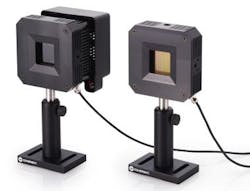Coherent creates piezoelectric thin-film detector that outdoes photodiodes and thermopiles for high-speed laser measurement

Santa Clara, CA--At SPIE Photonics West 2014 (1 to 6 Feb. 2014; San Francisco, CA), Coherent, Inc. introduced a high-speed, large-area, damage-resistant thin-film optical detector that is not a photodiode, and, according to Magnus Bengtsson, director of strategic marketing at Coherent, has advantages over both photodiodes and thermopiles for high-speed, high-power laser-beam power measurement.
New detector technology
The detector, which is called the PowerMax Pro, consists of a microns-thick thermoelectric layer on a heat sink; because the heat path is so short, the detector's response time is below 10 μs, as compared to the response time of more than 1 s for thermopile detectors, which have to conduct absorbed heat a centimeter or more from the center to the edge of the detector.
The piezoelectric film of the detector has a very broadband response. In one version, the detector's film has an additional coating that gives it a spectral-response range of 300 nm to 11 μm. A second, high-damage-threshold (up to 14 kW/cm2) version without the extra coating covers two spectral ranges (at the same time) -- 300 to 1100 nm and 9.5 to 11 μm. Both versions have a power range of 50 mW to 150 W with a noise-equivalent power (NEP) under 5 mW.
The detectors can be water cooled, fan cooled, or passively (convection) air cooled.
For more info, see: http://www.coherent.com.

John Wallace | Senior Technical Editor (1998-2022)
John Wallace was with Laser Focus World for nearly 25 years, retiring in late June 2022. He obtained a bachelor's degree in mechanical engineering and physics at Rutgers University and a master's in optical engineering at the University of Rochester. Before becoming an editor, John worked as an engineer at RCA, Exxon, Eastman Kodak, and GCA Corporation.